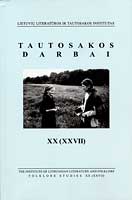Mįslių sisteminimo problemos
Problems of riddles systematization
Author(s): Aelita KensminienėSubject(s): Customs / Folklore
Published by: Lietuvių literatūros ir tautosakos institutas
Keywords: Riddles; classification; systematization
Summary/Abstract: The subject of this article is systematization of riddles, particularly the system card catalogue of Lithuanian riddles. The author also surveys the existing and possible principles of riddles systematization, introduces the card catalogue of Lithuanian riddles, presently under compilation at the Institute of Lithuanian Literature and Folklore, discusses principles and shortcomings of this work, as well as describing practical problems inherent in the riddles systematization and classification, and suggesting possible solutions. The article essentially deals with specifics of working with so-called true riddles, or “object” riddles, because only such riddles have been more or less consistently systematized so far. Among the causes of such situation, the virtual absence of the exact riddle classification as well as genre definitions could be named. The author suggests provisional working classification of the riddles. There are numerous cases, when the first part of the riddle preserves amazing stability, whereas the answers can be entirely different. This allows researcher to consider the possibility of classifying riddles according to the first part of the riddle. Various possibilities could be discussed here, taking into consideration syntactical or logical constructions, as pointed out in the study by Archer Taylor, “English Riddles from Oral Tradition”. Up till now, types in the system card catalogue of Lithuanian riddles have been formed intuitively, as no strict criteria of type definition had been worked out. According to the author of the article, priority in the type definition should be given to the poetical image, created by the interactions of realities. Discerning syntactical and logical constructions should also be helpful in defining riddle types. Variations of the lexical expressions are important in defining versions (sub-types), whereas the type definition rests upon the general semantic field and the nuclear image, which is always stable in riddles and normally is located at the end of the riddle. In Lithuanian card catalogue, riddles have been initially systematized according to the answers, in alphabetical order. As the same riddle text /question can have several different answers, this practice resulted in absolutely similar riddle texts being scattered across the whole catalogue. At present, such riddles are being interconnected via cross-references: thus the importance of the text is acknowledged, although the answer formally remains the prime criterion of systematization. Finally, all the variants ought to be interconnected. The broad context of riddle would be among the chief advantages of such system, as it would present both the scope of answers “capped” by the same question, as well as different riddle texts describing the same real object. The classification according to the answers guarantees easy access to the variety of ways, by which different real objects are described or masked...
Journal: Tautosakos darbai
- Issue Year: 2004
- Issue No: 27
- Page Range: 124-133
- Page Count: 10
- Language: Lithuanian

